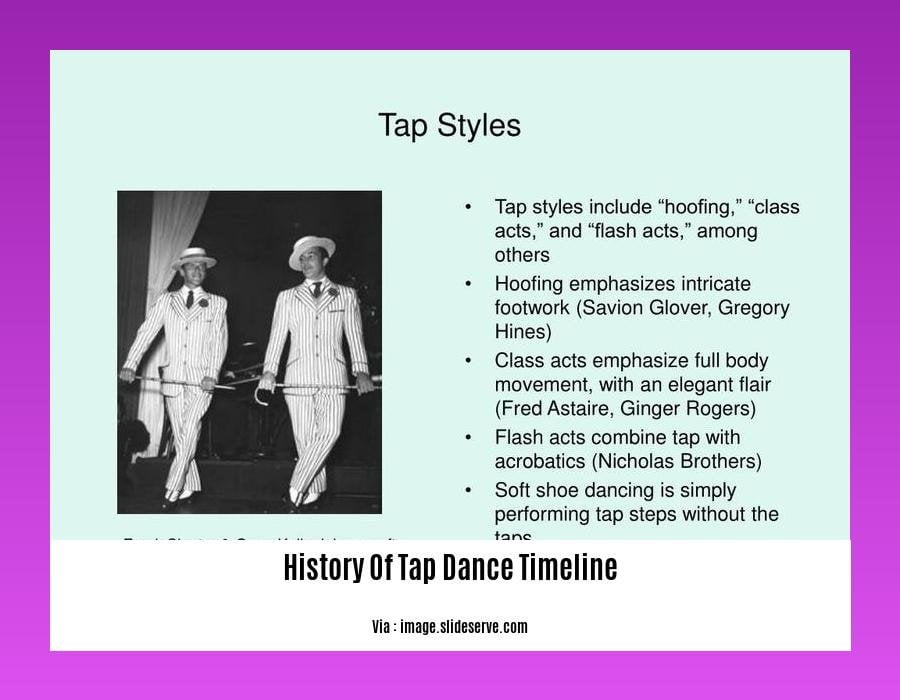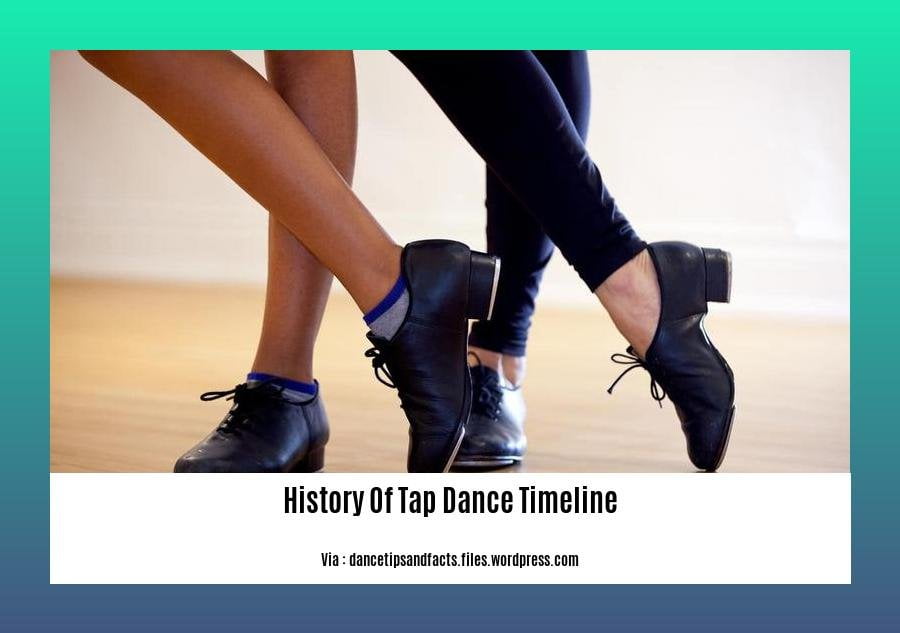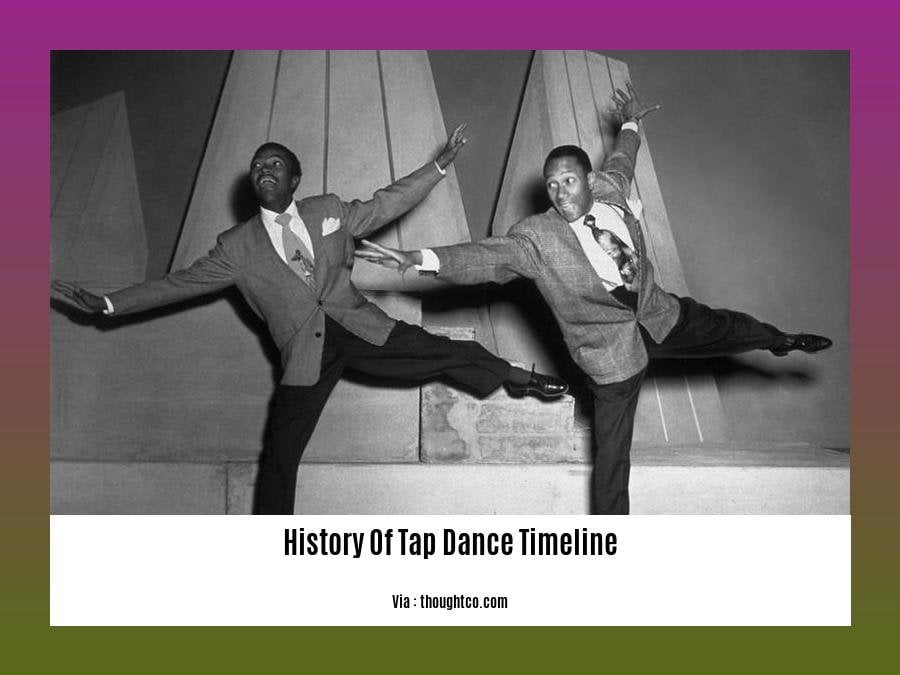Embark on a rhythmic journey through time as we delve into the captivating history of tap dance, a captivating art form that has captivated audiences for centuries. From its humble origins in the vibrant streets of Africa to its triumphant rise on global stages, tap dance has left an indelible mark on the cultural landscape. Get ready to explore the fascinating timeline of tap, tracing its evolution from traditional African dances to the mesmerizing performances that grace stages today.
Key Takaways:
Tap dance originates in the fusion of African and Irish dance forms in the early 19th century United States.
African Americans developed tap dance as a response to being denied traditional percussion instruments by slave owners.
Tap dance gained popularity through vaudeville variety shows in the early 20th century.
Noteworthy tap dancers of the Golden Age include Eleanor Powell, Ann Miller, Fred Astaire, and the Nicholas Brothers.
Modern tap dance has evolved to become more experimental, incorporating elements from other dance styles, like hip-hop and contemporary dance.
History of Tap Dance Timeline

It all started in the early 19th century…
Like a rhythm born from resilience, tap dance emerged from the African-American communities in the United States. Stripped of their traditional drums, they found a new beat, a new voice, through the percussive power of their feet. African and Irish dance influences intertwined, giving birth to a captivating fusion that would change the course of dance history.
Age of Vaudeville: Tap Takes the Stage
The early 20th century saw tap dance reach new heights of popularity. Vaudeville variety shows became the breeding ground for tap’s finest, where stars like the Nicholas Brothers, Fred Astaire, Eleanor Powell, and Ann Miller ignited the stage with their electrifying performances.
With each tap, each shuffle, the world fell in love with this rhythmic spectacle, its infectious energy mirroring the heartbeat of a nation. Tap became synonymous with joy, with freedom, and with the pursuit of dreams.
Modern Era: A Fusion of Styles
As the decades rolled on, tap dance evolved, adapting to the ever-changing landscape of dance. It embraced elements of hip-hop, jazz, and contemporary dance, creating a vibrant tapestry of rhythm and movement.
Modern tap dancers like Savion Glover, Gregory Hines, and Michelle Dorrance pushed the boundaries of the art form, showcasing its versatility and its ability to captivate audiences with its raw energy and emotional depth.
Tap Dance Today: A Living Legacy
In the 21st century, tap dance continues to thrive, its legacy secure in the hearts of dance enthusiasts worldwide. Tap schools and festivals abound, nurturing the next generation of tap dancers, ensuring that this rhythmic tradition will live on for generations to come.
Tap dance is more than just a dance style; it’s a testament to the human spirit, a celebration of cultural fusion, and an embodiment of the American dream.
Timeline at a Glance
| Era | Highlights | Key Figures | |---|---|---| | Early 19th Century | African and Irish influences merge to create tap dance | N/A | | Early 20th Century | Tap gains popularity in vaudeville variety shows | The Nicholas Brothers, Fred Astaire, Eleanor Powell, Ann Miller | | Mid-20th Century | Tap evolves and incorporates elements from other dance styles | Bill Robinson, Sammy Davis Jr., Gregory Hines | | Late 20th Century | Tap continues to evolve and becomes more experimental | Savion Glover, Michelle Dorrance, Jason Samuels Smith | | 21st Century | Tap thrives worldwide, with tap schools and festivals keeping the tradition alive | Various contemporary tap dancers |
Tap Dance: A Rhythmic Tapestry of History
Tap dance is a testament to the enduring power of rhythm, the resilience of the human spirit, and the beauty of cultural fusion. It’s a dance that has stood the test of time, evolving and adapting to the ever-changing landscape of the world.
As we move forward, let’s continue to celebrate this vibrant art form, to honor its rich history, and to support the next generation of tap dancers who will carry its legacy into the future.
Learn more about the evolution of eco-friendly practices in the fashion industry by exploring the history of sustainable fashion.
Discover the fascinating roots of swordsmanship and its influence on modern combat sports in the comprehensive history of swordsmanship.
Embark on a journey through time to uncover the origins and development of the beloved toy Sylvanian Families , capturing the hearts of generations.
Golden era of tap dance and its legends

When we mention the most exhilarating era of tap dance history, one can’t help but reminisce about the “Golden Age of Tap” that graced the world with its rhythmic beats and awe-inspiring performances. This era, spanning from the vibrant 1920s to the lively 1950s, witnessed the birth of legendary dancers who transformed tap into an art form that captivated the hearts and souls of audiences worldwide.
During this time, tap dance was a staple of vaudeville shows, where extraordinary hoofers showcased their skills on grand stages, leaving audiences breathless with their intricate footwork and infectious energy. Names like Bill Robinson, known as the “Father of Tap,” and the Nicholas Brothers, with their gravity-defying leaps and synchronized routines, became synonymous with this extraordinary era.
The Golden Age was not just about virtuosic performances; it also marked a period of profound innovation and evolution for tap dance. Dancers began experimenting with new rhythms, styles, and techniques, pushing the boundaries of the art form. This era saw the emergence of Broadway tap, characterized by its theatrical flair and storytelling elements, and the rise of rhythm tap, with its emphasis on intricate syncopated beats.
The stars of the Golden Age were not only exceptional dancers but also trailblazers who broke racial and gender barriers. African American dancers like Bill Robinson and the Nicholas Brothers faced discrimination and segregation but persevered, paving the way for future generations. Female tap dancers like Eleanor Powell and Ann Miller shattered stereotypes, showcasing their exceptional talent and proving that tap was not just a man’s world.
Their influence extended beyond the stage, as these legends graced the silver screen, bringing the magic of tap to millions through iconic movie musicals. Fred Astaire and Ginger Rogers, with their effortless grace and precision, set the standard for cinematic tap, charming audiences with their unforgettable routines.
The Golden Age of Tap was a time of unparalleled artistry, innovation, and cultural significance. It left an indelible mark on the world of dance, inspiring generations of tap dancers and captivating audiences with its enduring magic.
Key Takeaways:
- Birth of Legends: The Golden Age introduced legendary dancers like Bill Robinson, the Nicholas Brothers, Eleanor Powell, and Ann Miller, who revolutionized tap with their extraordinary skills.
- Evolution and Innovation: This era witnessed experimentation with new rhythms, styles, and techniques, leading to the birth of Broadway tap and rhythm tap.
- Breaking Barriers: Tap dancers like Bill Robinson and the Nicholas Brothers challenged discrimination, while female dancers like Eleanor Powell and Ann Miller shattered gender stereotypes.
- Silver Screen Magic: Tap’s magic extended to the movies, with stars like Fred Astaire and Ginger Rogers captivating audiences with their iconic cinematic routines.
- Enduring Legacy: The Golden Age left a lasting impact on the world of dance, inspiring future generations and solidifying tap’s place as a cherished art form.
References:
- Tap Dance | History, Origins, & Facts | Britannica
- The Golden Age of Tap Dance | American Tap Dance Foundation
Decline and Revival of Tap in the 20th Century
Picture the vibrant dance halls of the early 1900s, where the rhythmic tapping of feet against the wooden floors echoed through the air. Tap dance, a captivating fusion of African and European influences, had taken center stage, captivating audiences with its infectious beats and dazzling displays of skill.
However, as the 20th century progressed, tap dance faced a gradual decline in popularity. The rise of new dance forms, changing tastes, and the impact of the Great Depression all contributed to its waning presence in the spotlight.
Causes of the Decline:
- Changing Tastes: The advent of new dance styles, such as jazz and swing, captured the public’s attention, leading to a shift in preferences away from tap.
- Economic Downturn: The Great Depression severely impacted the entertainment industry, resulting in fewer opportunities for tap dancers to perform.
- Lack of Recognition: Tap dance was often seen as a form of entertainment for the masses rather than a legitimate art form, leading to a lack of recognition and support.
Despite these challenges, tap dance refused to fade into obscurity. The 1980s witnessed a remarkable revival, sparked by the success of Broadway shows like “42nd Street” and “The Tap Dance Kid.” These productions rekindled interest in tap, showcasing its artistry and captivating audiences once again.
Factors Contributing to the Revival:
- Broadway Renaissance: The success of tap-centric Broadway shows brought renewed attention and appreciation to the art form.
- Film and Television: Tap dance made a comeback in film and television, with movies like “Tap” and TV shows like “Fame” featuring memorable tap sequences.
- Cultural Shifts: A growing appreciation for diversity and a desire to preserve cultural heritage contributed to the revival of interest in tap dance.
Today, tap dance continues to thrive, taught and performed worldwide. It remains a vibrant and expressive art form, captivating audiences with its unique blend of rhythm, movement, and artistry.
Key Takeaways:
- Tap dance faced a decline in popularity in the mid-20th century due to changing tastes, economic factors, and lack of recognition.
- The 1980s marked a revival of interest in tap dance, driven by the success of Broadway shows and increased exposure in film and television.
- Today, tap dance is celebrated and performed worldwide, showcasing its enduring appeal and artistry.
Contemporary Tap Dance and Its Global Impact:
From its humble beginnings in the bustling streets of America, tap dance has captivated audiences worldwide, evolving into a dynamic and expressive art form. Join us on a journey through time as we explore the global impact of contemporary tap dance, its captivating rhythms, and its indelible mark on the world of performing arts.
A Fusion of Cultures:
Tap dance emerged as a unique blend of African, Irish, and Native American dance traditions, each contributing to its distinct percussive style. In the 19th century, African American performers fused these diverse elements, creating a vibrant and infectious dance form that resonated with audiences across the nation.
The Vaudeville Era:
The rise of vaudeville in the early 20th century provided a platform for tap dancers to showcase their extraordinary skills. Stars like Bill “Bojangles” Robinson, Eleanor Powell, and Fred Astaire captivated audiences with their intricate footwork, dazzling stage presence, and infectious energy. Tap dance became an integral part of vaudeville shows, propelling it to mainstream popularity.
Broadway and Hollywood:
Tap dance’s success in vaudeville paved the way for its integration into Broadway musicals and Hollywood films. Its rhythmic beats and visual spectacle added a dynamic element to these productions, captivating audiences and leaving a lasting impression. The Golden Age of Hollywood saw legendary tap dancers like Sammy Davis Jr. and Gene Kelly grace the silver screen, further solidifying tap dance’s status as a beloved form of entertainment.
Contemporary Evolution:
In the contemporary era, tap dance has undergone a remarkable evolution, embracing diverse influences from jazz, hip-hop, and modern dance. Tap dancers today push the boundaries of the art form, incorporating innovative techniques and styles to create a truly global tapestry of tap.
A Global Phenomenon:
Tap dance has transcended national borders, captivating audiences worldwide with its infectious rhythms and universal appeal. Tap dance festivals, competitions, and workshops are held across the globe, fostering a vibrant community of tap enthusiasts who celebrate the art form’s rich history and diverse expressions.
Key Takeaways:
Tap dance emerged as a fusion of African, Irish, and Native American dance traditions.
Vaudeville provided a platform for tap dancers to showcase their skills, propelling it to mainstream popularity.
Tap dance graced Broadway musicals and Hollywood films, captivating audiences with its rhythmic beats and visual spectacle.
Contemporary tap dance embraces diverse influences, creating a global tapestry of innovative techniques and styles.
Tap dance has become a global phenomenon, celebrated through festivals, competitions, and workshops worldwide.
Sources:
Tap Dance in America: A Short History
FAQ
Q1: When did tap dance originate?
A1: Tap dance emerged in the United States during the 19th century as a fusion of various percussive dance traditions, including English and Irish step dancing, African American juba dancing, and Native American stomp dancing.
Q2: How did tap dance gain popularity in the early 20th century?
A2: Tap dance gained widespread recognition and popularity as part of vaudeville variety shows during the early 20th century. Many talented tap dancers, such as Bill “Bojangles” Robinson, gained fame and established the dance form as a celebrated aspect of American popular culture.
Q3: What was the role of tap dance in Broadway musicals and Hollywood films?
A3: Tap dance played a significant role in Broadway musicals and Hollywood films, further solidifying its place in American popular culture. It showcased the talents of exceptional tap dancers and contributed to the overall entertainment value of these productions.
Q4: Why did the popularity of tap dance decline in the second half of the 20th century?
A4: While tap dance experienced tremendous popularity in the early to mid-20th century, its popularity declined in the latter half due to changing tastes and the rise of other dance forms. Audiences’ preferences shifted, and tap dance faced competition from other emerging dance styles.
Q5: How has tap dance been revived and preserved in the contemporary era?
A5: Tap dance has experienced a revival and preservation in the contemporary era through various means. Tap dance continues to be taught and performed worldwide. It is often incorporated into various dance styles, including jazz, ballet, and modern dance. Additionally, festivals, workshops, and performances celebrate tap dance and its contributions to American cultural heritage.
- Sept 31 Myth: Unveiling Calendar Secrets - March 18, 2025
- How Long & Till December 18, 2025: Accurate Countdown Guide - March 18, 2025
- Discover Japanese Artists: A Complete History - March 18, 2025
















